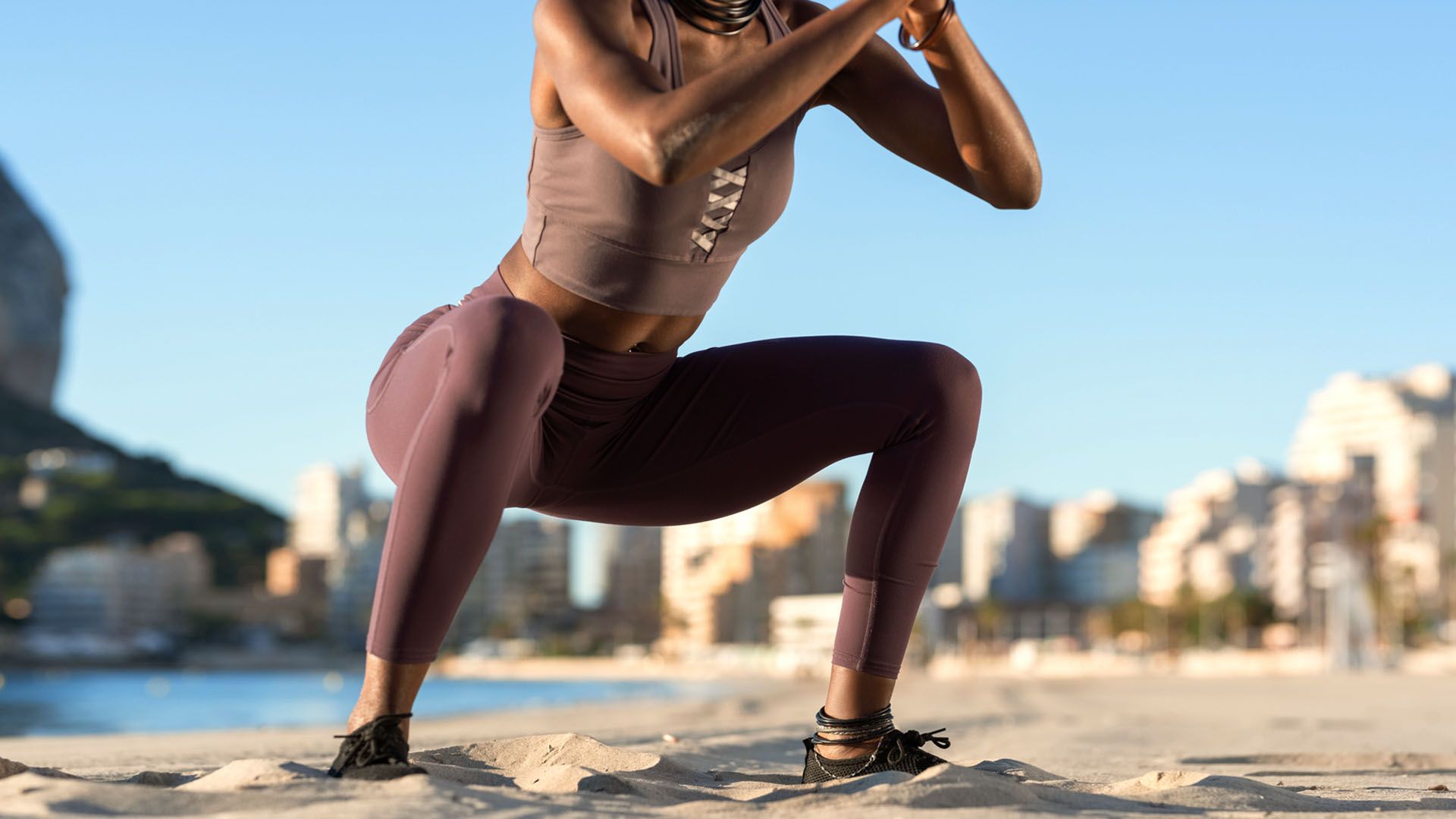Moving like our ancestors did has both physical and mental benefits. Here are six easy ways that you can try primal movement for increased mobility, strength, and cognitive function.
Going back to our roots is a major wellness theme — consider the continued popularity of practices like the paleo (aka caveman) diet, in which people are encouraged to eat the way ancient humans did. This idea of ancestral simplicity has also carried over into the fitness world with the rise of the practice of primal movement.
Primal movement focuses on the basic actions that humans have performed throughout history — such as crawling, squatting or crouching, and running, all skills we needed to survive and thrive — to create modern-day exercise routines. You might be familiar with a number of these already (think squats, lunges, jumps), but you may not know that these movements have many benefits beyond simple aerobic activity. Below, experts explain why these primal movements are so fundamentally important to humans and suggest a few you can try to reap their physical and mental benefits.
What Is Primal Movement?
Primal movement is essentially the “fundamental movements that humans are evolutionarily designed to perform in order to survive and thrive in their environment,” certified personal trainer Joe Johnson tells DailyOM. He explains that these movements are given that “primal” moniker because they are foundational to our physical development as human beings and have been a part of our movement patterns for thousands of years.
“Primal movements are also important for developing functional strength, mobility, and stability, which can help to prevent injuries and improve overall physical performance,” he explains. “These movements are essential to our daily lives and include activities such as crawling, walking, running, jumping, squatting, lunging, pushing, pulling, and twisting.”
Because primal movements are developed around the way the body moves naturally, says Jack Craig, a certified personal trainer with Inside Bodybuilding, they allow people to get stronger without putting unnecessary stress on the body. “Our joints and muscle systems have movement patterns built into their geometry,” he tells DailyOM. “Incorporating these movement patterns into your regular routine helps build a more well-rounded body that can keep you healthy and strong.”
Interested in learning more? Check out Primal Movement for Aches and Pains
What Are the Benefits of Primal Movement?
According to the experts who spoke to DailyOM, there are numerous physical and mental benefits to practicing primal movement exercises, particularly as we age. Here are the nine most important advantages of doing primal movement.
1. Integrates the Whole Body
Johnson explains that many primal movements are compound exercises — meaning that they typically involve multiple muscle groups and joints working together in a coordinated manner. “These movements can help to improve overall body integration — how your body works as a whole — which can enhance athletic performance and reduce the risk of injury,” he says. As your major muscle groups practice working together, your body becomes more synchronized.
2. Minimal (or No) Equipment Required
Because primal movements can be performed with little to no equipment, Johnson says they are a convenient and cost-effective option for exercise. This lowers the barrier for those who can’t afford a monthly gym membership or aren’t able to find the time to attend scheduled workout classes.
“Our joints and muscle systems have movement patterns built into their geometry. Incorporating these movement patterns into your regular routine helps build a more well-rounded body that can keep you healthy and strong.”
3. Suitable for All Fitness Levels
According to Johnson, anyone can perform primal movements because they are adaptable and work with your body’s natural inclinations, making them excellent for beginners to advanced athletes. Modifications like doing push-ups on your knees or reducing the range of motion for squats and lunges can make these movements more accessible.
4. Improves Cardiovascular Health
Like other forms of exercise, primal movement is also beneficial for heart health, says Reda Elmardi, a certified strength and conditioning specialist trainer, registered dietitian, and certified nutritionist. “A main benefit of primal movement for fitness is how it helps improve your cardiovascular health,” he tells DailyOM. “This includes everything from improving your heart rate to reducing your risk of heart disease.”
5. Reduces Inflammation
Elmardi notes that primal movement training can also reduce inflammation throughout the body, as well as improve joint range of motion. “Primal movement strengthens muscles around the joints, which can reduce pain and inflammation around those joints,” he says. “Strengthening muscles around the joint reduces the load on that joint and can also preserve the joint.”
6. Strengthens Cognitive Function
There are also mental benefits to doing primal movement, according to Elmardi. “Regular exercise improves cognitive function-related tasks like memory recall and problem-solving,” he says. “This can be due to the increased levels of oxygenation and blood flow to the brain caused by regular exercise.”
7. Increases Strength and Helps Maintain Muscle
Performing primal movements regularly will help improve your strength, particularly if you’re doing exercises like deadlifts, squats, and push-ups, Craig says, because they help recruit a lot of our biggest muscle systems.
This can be particularly important as people age, he adds, since part of the natural aging process is a type of muscle loss called sarcopenia. (The medical definition of “sarcopenia” is the gradual loss of muscle mass, strength, and function, and it can be exacerbated by physical inactivity, obesity, and certain chronic diseases.) “Practicing primal movements ensures you can resist the effects of sarcopenia, keeping your strength and athletic ability,” he says.
8. Helps With Balance
Craig explains that core stability and rotation are “essential for keeping balance.” (He says our core strength can wane if we sit for long periods of time and don’t get regular exercise, and those weak muscles are therefore “not prepared to help you out if you do lose your balance.”) When older people work their core and upper body regularly, he says, they can more easily regain balance before falling, which then reduces their chances of injury.
9. Improves the Mind-Body Connection
Finally, there’s an overall wellness component to primal movement, board-certified psychiatrist Harold Hong, MD, tells DailyOM. “Engaging in these types of activities can help reduce stress and improve mood by providing an outlet for releasing built-up tension and anxiety. They can also be a form of self-care as they help us reconnect with our body and mind.”
Dr. Hong explains that because primal movements focus on form and alignment rather than the number of repetitions performed, this awareness of the physical body helps to strengthen not just the muscles, but also the mind-body connection.
6 Primal Movement Exercises
If you’re interested in trying primal movement, Johnson offers six exercises you can start with. (It should be noted, however, that you should always talk with your doctor before starting an exercise program if you have any underlying health conditions.) For those who are new to regular workouts or are unfamiliar with the movements named below, you might want to take primal movement classes so you can be properly guided on form, and for suggested modifications as needed.
1. Squats
Squatting is a fundamental primal movement that involves bending the knees and hips to lower the body down to a seated position, and then standing back up. Examples of squat variations could include goblet squats, bodyweight squats, and front squats.
2. Crawls
Crawling is essentially moving on your hands and knees. This exercise can improve core stability, coordination, and total body strength. Examples of crawling exercises include bear crawls and crab walks. (For beginners, try a bear crawl in which you alternate keeping one knee on the ground.)
3. Pushing
Pushing involves using the upper body to push an object away from the body, or your own body away from the ground. Examples of pushing exercises are push-ups (on the floor or against the wall), bench presses, and overhead presses.
4. Pulling
This primal movement engages the upper body to pull an object toward the body. Examples of pulling exercises are pull-ups, chin-ups, and rows.
5. Lunging
This move involves stepping forward or backward with one foot and then lowering the body down until the knee of the opposite leg almost touches the ground. Lunges can be performed in any direction, including forward, reverse, and side. This movement can also be performed across the length of a space with walking lunges.
6. Jumping
Jumping is a movement in which you propell the body off the ground using the legs. Some common jumping exercises are box jumps, broad jumps, and jump squats.
Making Primal Movement Exercises Work for You
If you decide to try primal movement training, Craig says that the most important thing to remember is to focus on stability and to use your whole body to support your movements. “If you’re practicing a push-up, consider not just pressing with your arms and chest, but also making sure to build stability in your shoulders, lats, and glutes to keep your back straight through the movement,” he explains.
Engaging multiple muscle groups helps you have good form, which is also crucial to getting the most out of these exercises and avoiding injury. This is why it’s so important to always listen to your body and adjust the movements accordingly.
“You don’t want to strain or push through limitations,” Craig says. “Move with your body’s needs, and modify as you build strength to maintain good form.” This might mean doing push-ups on your knees, for example, or practicing reverse lunges until you feel comfortable trying a forward lunge. As you get stronger and more coordinated, you can move toward doing more advanced movements without adding stress to your body.

